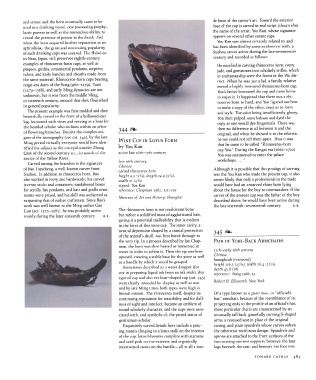Page 486 - Art In The Age Of Exploration (Great Section on Chinese Art Ming Dynasty)
P. 486
and armor, and the horn eventually came to be de force of the carver's art. Toward the exterior
used as a drinking vessel, one possessing prophy- base of the cup is carved in seal script (zhuan shu)
lactic powers as well as the miraculous ability to the name of the artist, You Kan, whose signature
reveal the presence of poison in the drink. And appears on several other extant cups.
when the horn acquired further reputation as an You Kan was almost certainly related to, and
aphrodisiac, the great and continuing popularity has been identified by some as identical with, a
of such drinking cups was assured. The Shoso-in Suzhou carver active during the late seventeenth
in Nara, Japan, still preserves eighth-century century and recorded as follows:
examples of rhinoceros-horn cups, as well as He excelled in carving rhinoceros horn, ivory,
plaques, girdles, ornamental pendants, scepters, jade, and gemstones into scholarly trifles, which
rulers, and knife handles and sheaths made from in craftsmanship were the finest in the Wu dis-
the same material. Rhinoceros-horn cups bearing trict. When he was just a lad, a family relative
reign-era dates of the Song (960-1279), Yuan owned a highly treasured rhinoceros-horn cup.
(1279-1368), and early Ming dynasties are not You's father borrowed the cup and came home
unknown, but it was from the middle Ming, to enjoy it. It happened that there was a rhi-
or sixteenth century, onward that they flourished noceros horn to hand, and You figured out how
in general popularity. to make a copy of the other, exact as to form
The present example was first molded and then and style. The color being insufficiently glossy,
beautifully carved in the form of a hollowed-out You then pulped some balsam and dyed the
log, festooned with vines and serving as a boat for copy as one would dye fingernails. There was
the bearded scholar who reclines within an arbor then no difference at all between it and the
of flowering branches. Despite the complex ori- 344 original, and when he showed it to the relative,
gins of the iconography (see cat. 342), by the late WINE CUP IN LOTUS FORM he too could not tell them apart. Thus it was
Ming period virtually everyone would have iden- that he came to be called "Rhinoceros-horn
tified the subject as the intrepid traveler Zhang by You Kan cup You/ During the Kangxi era (1662-1722)
7
Qian of the second century B.C. , in search of the active late i6th-i7th century You was summoned to enter the palace
source of the Yellow River. workshops.... "
Carved among the branches is the signature late i6th century
Chinese
of Bao Tiancheng, a well-known carver from carved rhinoceros horn Although it is possible that this prodigy of carving
Suzhou. In addition to rhinoceros horn, Bao height 9.5 f3 /4J, length 14.9 (5 /s), was the You Kan who made the present cup, it also
3
7
also worked in ivory and hardwoods; his carved width 11 (4 /s) seems likely that only a professional in the trade
3
incense sticks and containers, sandalwood boxes signed: You Kan would have had an uncarved rhino horn lying
for scrolls, fan pendants, and hair and girdle orna- reference: Chapman 1982, 101-105 about the house for the boy to commandeer. If the
ments were prized, and his skill was acclaimed as Museum of Art and History, Shanghai carver of the present cup was the father of the boy
surpassing that of earlier craftsmen. Since Bao's described above, he would have been active during
work was well known to the Ming author Gao the late sixteenth-seventeenth century. H.R.
Lian (act. 1573-1581), he was probably active The rhinoceros horn is not recalcitrant bone
mainly during the later sixteenth century. H.R. but rather a solidified mass of agglutinated hair,
giving it a potential malleability that is evident
in the form of this wine cup. The inner cavity, a
natural depression shaped by a cranial protrusion 345
of the animal's skull, was first bored through to
the very tip. In a process described by Jan Chap- PAIR OF YOKE-BACK ARMCHAIRS
man, the horn was then heated or immersed in
water in order to soften it. Then the tip was bent i$th-early i6th century
upward, creating a stable base for the piece as well Chinese (rosewood)
huanghuali
as a handle by which it could be grasped. height 116.3 (45 J' width 56.4 (22 /4J,
2
3//4
Sometimes described as a water dropper (for depth 45.8 (18)
use in preparing liquid ink from an ink stick), this reference: Wang 1986, 15
type of cup and also the boat-shaped cup (cat. 343)
were clearly intended for display as well as use, Robert H. Ellsworth, New York
and by late Ming times both types were high in
literati esteem. The rhinoceros itself, despite its Of a type known as a guan mao f or "official's
continuing reputation for irascibility and for dull- hat/' armchair, because of the resemblance of its
ness of sight and intellect, became an emblem of projecting ends to the profile of an official's hat,
sound scholarly character, and the cups were asso- these particular chairs are characterized by an
ciated with, and symbolic of, the prized status of unusually tall back, gracefully curving S-shaped
gentleman-scholar. arms, a recessed seat in place of the original
Exquisitely carved details here include a pray- caning, and plain spandrels whose curves soften
ing mantis clinging to a lotus stalk on the interior the otherwise rectilinear design. Spandrels and
of the cup, lotus blossoms complete with stamens aprons are attached to the front surfaces of the
and seed pods on the exterior, and organically two curving armrest supports, between the four
intertwined stems on the handle —all in all a tour legs beneath the seat, and beneath the foot rest,
TOWARD CATHAY 485

